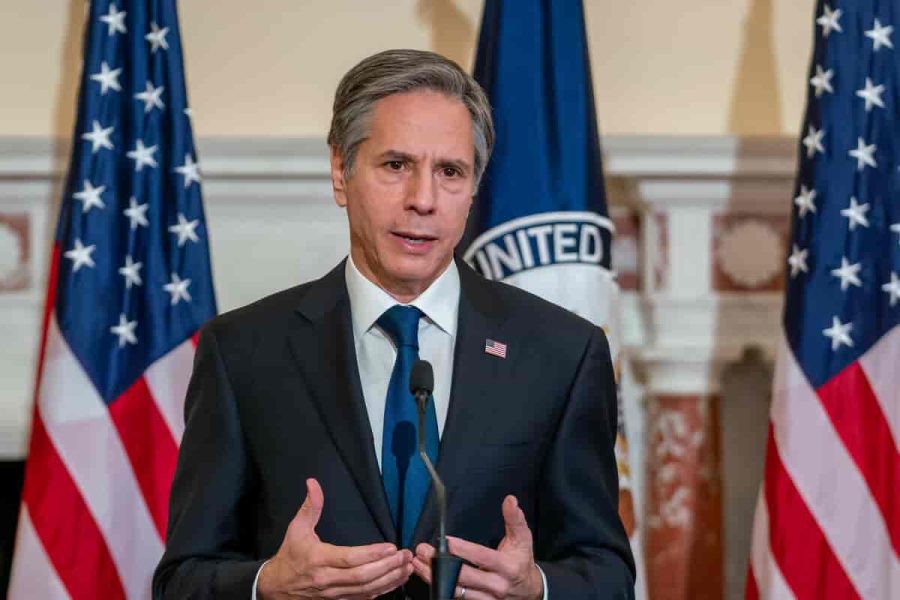The Spy Balloon Incident: A Retrospective Look
U.S. Secretary of State, Anthony Blinken addresses the nation on what the shot-down balloon means for the future.
March 9, 2023
Earlier this month, a Chinese observation balloon entered US airspace through Canada and flew east the American midwest, towards the Atlantic Ocean. In the ensuing week, a debacle arose between the Chinese Communist Party ,or CCP, and the Biden administration. Which ended with Biden’s Secretary of State, Antony Blinken, canceling his important visit to China. Chinese authorities argued that the balloon was simply a piece of weather equipment, but cabinet members in the US were angry at the intrusion of a “spy” vehicle into American airspace. Meanwhile, some of the president’s opponents in Congress criticized the White House’s apparent inaction, arguing that the surveillance equipment could be observing nearby military bases as it crossed the country. A few days later, US military aircraft shot down the balloon over the Atlantic Ocean. Over the coming days, they would shoot down three more miscellaneous flying objects.
This quickly raised questions as the truth of the situation became muddled. If the White House was planning to shoot down the balloon all along, why the wait? Was the balloon ever even a real threat to Americans? And what does China stand to gain by sending “spy” craft into US airspace?
First of all, it’s important to realize that shooting down the balloon immediately might have been more dangerous than letting it stay in the air. As the balloon’s remains were being recovered from the Atlantic Ocean just off the coast of South Carolina, military authorities described the craft as being over 200 feet tall, and weighing several thousand pounds. That means the CCP’s surveillance balloon was about the size of a 20-story building, with a diameter comparable to the wingspan of a Boeing 747. You can imagine the dangers of shooting down something this size over the American mainland. Not only that, but when the balloon finally was shot down, it scattered debris in an area seven miles wide. This, combined with the floaty nature of balloons, would make it very hard to estimate exactly where the pieces of the craft would fall. The Biden administration claimed that it wanted to avoid any civilian injuries or property damages resulting from such an explosion. Biden himself claimed that he issued orders for the military to shoot down the balloon “as soon as possible” when he received information about the balloon last Wednesday.
But despite the reasonable fears that shooting down the vehicle might have caused damage to buildings or people on the ground, there are plenty of spots (especially in a state like Montana, with a population density of less than eight people per square mile) at least seven miles wide to shoot the craft down over American soil. Perhaps the military waited to shoot down the balloon not just because shooting it down would have been particularly dangerous, but also because forcing the balloon to fall into water would allow the US to collect valuable data about its design and purpose. Generally, falling aircraft try to aim for water because water landings are often safer for the craft, but land is sometimes the better option because it poses a lower danger to inhabitants than the vehicle. In this case, the balloon is unmanned, so a shoot-down over water probably has a higher chance of preserving the pieces of the balloon for later study.
It seems that the data collected from the craft’s remains has been very useful to the American government: namely, the FBI. The State Department has just released its opinion that the balloon was trying to intercept sensitive government communications. Furthermore, Washington is considering “taking action” against Chinese authorities over the incident. Just recently, the FBI has obtained the “payload” of the craft, which should contain the vehicle’s surveillance information. In the coming days, it’s likely that the information gleaned from the balloon’s instruments will cause tensions to rise between China and the US.
“We’re analyzing them as I speak,” President Biden said. “And what we learn will strengthen our capabilities.”
But why would China send a balloon like this into American airspace in the first place? With the balloon easily visible in the sky for miles around, it’s hard to believe that this was supposed to be a secret flight. It would seem that whatever data the balloon was collecting was worth the risk to the CCP of it being discovered by American authorities. However, it’s possible that the Chinese government was banking on the balloon being just strange enough that they could maintain plausible deniability about the whole thing. After all, a spy plane or drone flying across the whole US would be an obvious breach of US airspace, but a weird balloon? It’s easier to deny that something like that wasn’t connected to a spying attempt.
In addition it’s worth noting that balloons of this type can fly at about 100,000 feet in the air, and at such a height, there aren’t a lot of options for shooting them down, or even detecting them. After all, most American air defense weapons are not designed to hit targets so high in the air. Considering this, it’s possible that America was never supposed to know about this flight. Even if authorities from the military discovered these strange balloons, they might decide that it would be better not to inform the American public about the threat, since they were unable to shoot it down. This balloon may simply have encountered a patch of bad weather that brought it down to 60,000 feet.
This theory was given more credibility after the US military claimed that Chinese balloons have been flying undetected above America for years. Plus, Chinese authorities claim that America has been flying similar craft over China, and has done it “more than 10 times.” Although as of now the balloon has been labeled as “not a major security breach” by the Biden administration, this may not be the last time that Chinese and American authorities have a flight over balloons.
Somewhat comedically, the incident was followed by the military’s decision to shoot down three more flying objects in the past two weeks, all of which turned out to be benign and probably civilian or business craft. Citing an abundance of caution, President Biden publicly announced that the other three “slow moving objects” were “most likely tied to private companies, recreation or research organizations.” Oops. Just a week before last, a large iron sphere was found on a beach in Japan, to the confusion of authorities and citizens alike. Between big balloons and solid spheres, it seems like our UFO adventures are not quite over yet: even if there aren’t any aliens involved.



